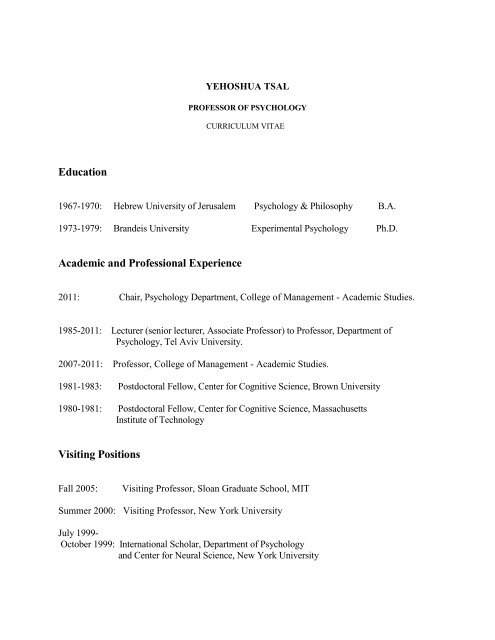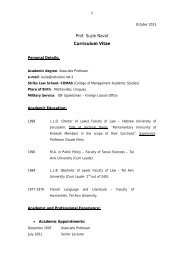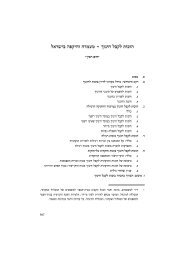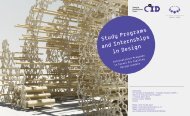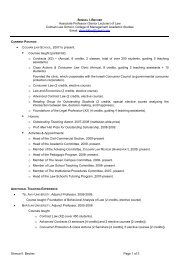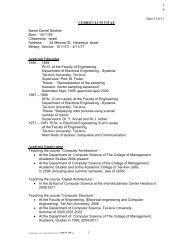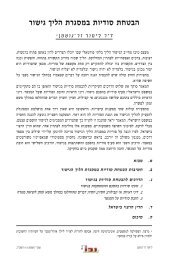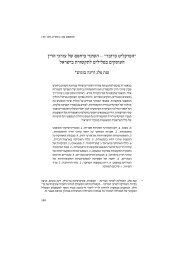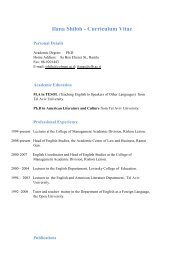Education Academic and Professional Experience Visiting Positions
Education Academic and Professional Experience Visiting Positions
Education Academic and Professional Experience Visiting Positions
You also want an ePaper? Increase the reach of your titles
YUMPU automatically turns print PDFs into web optimized ePapers that Google loves.
YEHOSHUA TSAL<br />
PROFESSOR OF PSYCHOLOGY<br />
CURRICULUM VITAE<br />
<strong>Education</strong><br />
1967-1970: Hebrew University of Jerusalem Psychology & Philosophy B.A.<br />
1973-1979: Br<strong>and</strong>eis University Experimental Psychology Ph.D.<br />
<strong>Academic</strong> <strong>and</strong> <strong>Professional</strong> <strong>Experience</strong><br />
2011: Chair, Psychology Department, College of Management - <strong>Academic</strong> Studies.<br />
1985-2011: Lecturer (senior lecturer, Associate Professor) to Professor, Department of<br />
Psychology, Tel Aviv University.<br />
2007-2011: Professor, College of Management - <strong>Academic</strong> Studies.<br />
1981-1983: Postdoctoral Fellow, Center for Cognitive Science, Brown University<br />
1980-1981: Postdoctoral Fellow, Center for Cognitive Science, Massachusetts<br />
Institute of Technology<br />
<strong>Visiting</strong> <strong>Positions</strong><br />
Fall 2005:<br />
<strong>Visiting</strong> Professor, Sloan Graduate School, MIT<br />
Summer 2000: <strong>Visiting</strong> Professor, New York University<br />
July 1999-<br />
October 1999: International Scholar, Department of Psychology<br />
<strong>and</strong> Center for Neural Science, New York University
1987-1991: <strong>Visiting</strong> Associate Professor - Spring Quarters, University of Rochester<br />
1984-1985: <strong>Visiting</strong> Assistant Professor, Cornell University<br />
1983-1984: <strong>Visiting</strong> Assistant Professor, Purdue University<br />
<strong>Academic</strong> <strong>and</strong> <strong>Professional</strong> Awards<br />
2010-2014: The Israel Science Foundation ($144,000). Identifying the major determinants of<br />
effective attentional selection<br />
2009: Association for Psychological Science: Elected Fellow ("for sustained <strong>and</strong> outst<strong>and</strong>ing<br />
contributions to psychological science")<br />
2007-2010: The Israel Science Foundation ($100,000). The attentional white bear phenomenon:<br />
Validation <strong>and</strong> extension.<br />
2004-2007: The Israel Science Foundation ($90,000): A model for identifying impaired attentional<br />
functions in ADHD.<br />
2001-2004: Binational Science Foundation ($100,000): “Top-down <strong>and</strong> bottom-up processes in<br />
visual selection” (with Howard Egeth <strong>and</strong> Dominique Lamy)<br />
July 1999-<br />
Oct 1999:<br />
International Visitors Program Grant Winner, New York University,<br />
Psychology <strong>and</strong> Center for Neural Science.<br />
1998-2001: The Israel Science Foundation ($101,000): “Visual representations of<br />
attended <strong>and</strong> unattended objects".<br />
1995-1998: The Israel Science Foundation ($59,000): "Preattentive <strong>and</strong> attentive<br />
representations of visual information".<br />
1994-1999: Member of the Advisory Council of the International Association for the Study of<br />
Attention <strong>and</strong> Performance.<br />
1992-1995: The Israel Science Foundation ($ 55,000): "Effects of attention on length, brightness<br />
<strong>and</strong> orientation judgments".<br />
1992-1994: The Ford Foundation: "Effects of attention on length <strong>and</strong> brightness judgments”<br />
(Approved but declined because of Academy parallel grant).
1988-1990: Tel Aviv University, The Fund for Basic Research Grant: "The distribution of<br />
Spatial Attention over Complex Visual Stimuli".<br />
1986-1988: Tel Aviv University, The Israel Institute of Business Research Grant: “Processing<br />
information from advertisements”.<br />
1983-1984: Lady Davis Postdoctoral <strong>Visiting</strong> Fellowships, Jerusalem, Israel (declined).<br />
1982-1983: Alfred P. Sloan Foundation: Postdoctoral Fellowship<br />
1981-1982: Alfred P. Sloan Foundation: Postdoctoral Fellowship<br />
1980-1981: Alfred P. Sloan Foundation: Postdoctoral Fellowship<br />
Summer 1977: Br<strong>and</strong>eis University: NIH Biomedical Support Grant RR-07044-12<br />
1973-1978: Foster <strong>Academic</strong> Enrichment Fund: Fellowships; Teaching Assistantships<br />
Administrative Responsibilities<br />
2010 - Binational Science Foundation: Chairperson of the psychology committee allocating<br />
Grants for submitted research proposals<br />
2008 - Binational Science Foundation: Chairperson of the psychology committee allocating<br />
Grants for submitted research proposals<br />
2003 – 2007: Faculty representative in the University MA Committee<br />
2004 – 2007: Faculty representative in the University Research Committee<br />
2004 – 2005: Promotions <strong>and</strong> Appointments Committee, School of <strong>Education</strong><br />
1999 – 2001: Teaching Committee of the University Interdisciplinary Program for Outst<strong>and</strong>ing<br />
Students<br />
1998 – 2001: Faculty Ph.D. Committee<br />
1998 – 2001: Chair Ph.D. Committee<br />
1995 – 2001: University Students Appeal Committee
1995 – 1998: Chair, M.A. Committee<br />
1994 – 1998: Ph.D. Committee<br />
1994 – 1995: Chair, Cognitive Program<br />
1993 – 1995: M.A. Committee<br />
1992 – 1995: B.A. Committee<br />
1987 – 1992: Faculty Research Committee<br />
Membership in <strong>Professional</strong> Societies<br />
The Psychonomic Society<br />
Cognitive Neuroscience Society<br />
Vision Sciences Society<br />
Association for Psychological Sciences<br />
The European Society of Cognitive Psychology<br />
The Israeli Society of Cognitive Psychology<br />
Editorial Boards<br />
Journal of Experimental Psychology: Human Perception <strong>and</strong> Performance – Consulting Editor<br />
Attention <strong>and</strong> Performance: Member of the Advisory Council of the International Association for<br />
the Study of Attention <strong>and</strong> Performance.<br />
American Psychological Science: Elected Fellow<br />
Reviewer<br />
Extensive reviewing of articles for:<br />
Psychological Review<br />
Journal of Experimental Psychology: Human Perception <strong>and</strong> Performance<br />
Perception <strong>and</strong> Psychophysics<br />
Perception<br />
Cognitive Psychology<br />
Psychonomic Bulletin <strong>and</strong> Review
Visual Cognition<br />
Neuropsychologia<br />
Spatial Vision<br />
Acta Psychologica<br />
Quarterly Journal of Experimental Psychology<br />
Psychological reports<br />
Journal of General Psychology<br />
European Journal of Cognitive Psychology<br />
Extensive reviewing of proposals for:<br />
National Science Foundation<br />
Binational Scientific Foundation<br />
Israel Science Foundation<br />
Israel Foundation Trustees<br />
Charles Smith Foundation of Psychobiology<br />
Supervision of Doctoral Students<br />
1. Nilli Lavie: Perceptual load <strong>and</strong> physical distinctiveness as determinants of the locus of<br />
attentional selection. Psychology Department, Tel Aviv University. Graduated-1992.<br />
Currently Professor, University College of London.<br />
2. Nachshon Meiran: Reading ability differences in immediate repetition priming: Evidence for<br />
an activation dumping mechanism. Psychology Department, Tel Aviv University. Graduated-1993.<br />
Currently Professor, Ben Gurion University.<br />
3. Lilach Shalev-Mevorach: Effects of attention on length judgments of vertical lines. Psychology<br />
Department, Tel Aviv University. Graduated-1995.<br />
Currently Senior Lecturer, Hebrew University.<br />
4. Dominique Lamy: On the status of location in visual attention. Psychology Department, Tel<br />
Aviv University. Graduated –2000.<br />
Currently Associate Professor, Tel Aviv University.<br />
5. Tal Bareket: Effects of attention on localizing stimuli in the visual field. Psychology<br />
Department, Tel Aviv University. Graduated-1998.<br />
6. Ilan Losovsky: Resolution theory of visual attention: An empirical investigation. Psychology<br />
Department, Tel Aviv University. Graduated: 2003.
7. Avner Caspi: (Joint supervision with Prof. Wolfgang Prinz-Head, Max Planc Institute).<br />
Attentional priority cause negative asynchrony. Psychology Department, Tel Aviv University.<br />
Graduated: 2003.<br />
Currently Lecturer, Open University.<br />
8. Tal Makovsky: On the precedence <strong>and</strong> dominance of features vs. dimensions. Psychology<br />
Department, Tel Aviv University. Graduated: 2005<br />
Currently Postdoctoral Fellow, Harvard University-University of Minnesota.<br />
9. Alon Avissar: The four-component model of attention <strong>and</strong> ADHD. Psychology Department,<br />
Tel Aviv University. graduated 2009.<br />
10. Michl Shapira: The influence of observer <strong>and</strong> stimulus related factors on the attentioanl white<br />
bear effect. Psychology Department, Tel Aviv University. graduated 2009.<br />
Currently Lecturer, College of Kiryat Ono.<br />
11. Aya Lahav: The attentioanl white bear phenomenon: Extensions <strong>and</strong> boundaries. Psychology<br />
Department, Tel Aviv University. C<strong>and</strong>idacy approved 2006.<br />
12. Hanna Benoni: The dilution of perceptual load. Psychology Department, Tel Aviv University.<br />
C<strong>and</strong>idacy approved 2006.<br />
13. Ricardo Max: Alternative interpretations to Perceptual Load. Psychology Department, Tel<br />
Aviv University.<br />
C<strong>and</strong>idacy approved 2009.<br />
14. Rotem Avital: Mechanisms of facilitation <strong>and</strong> inhibition in visual selection. Psychology<br />
Department, Tel Aviv University.<br />
C<strong>and</strong>idacy approved 2010.
Active Participation in Scientific Meetings<br />
Tsal, Y. (1979). The role of capacity in visual focused attention. Paper presented at the annual meeting of<br />
the American Psychological Association, New York, NY.<br />
Ryder, J. & Tsal, Y. (1980). Attention dem<strong>and</strong>s of global <strong>and</strong> local visual processing. Paper presented at the<br />
annual meeting of the Eastern Psychological Association, Hartford, CT.<br />
Tsal, Y. (1980). Capacity dem<strong>and</strong>s of visual focused attention. Paper presented at the Cognitive Science<br />
Meeting, MIT, Cambridge, MA.<br />
Tsal, Y. (1981). Movements of attention across the visual field. Paper presented at the annual meeting of the<br />
American Psychological Association, Los Angeles, CA.<br />
Tsal, Y. (1983). The role of attention in the interpretation of ambiguous figures. Paper presented at the<br />
annual meeting of the American Psychological Association, Anaheim, CA.<br />
Tsal, Y. (1987). Allocating visual attention to location, color, <strong>and</strong> shape. Paper presented at the Israeli<br />
Psychological Association, Tel Aviv, Israel.<br />
Tsal, Y. (1987). Location precedence in processing visual information. Invited lecture, The Bat Sheva<br />
International Seminar in Attention <strong>and</strong> Sensory Processing. Jerusalem.<br />
Tsal, Y., & Lavie, N. (1989). Attending to locations in the selective processing of colors. Paper presented at<br />
the annual meeting of the Psychonomic Society, Atlanta, Georgia.<br />
Tsal, Y., & Mevorach, L. (1990). Effects of attention on brightness perception. Paper presented at The First<br />
Conference of the Israeli Cognitive Society, Beer Sheva, Israel.<br />
Tsal, Y., Mevorach, L. (1991). Effects of attention on length <strong>and</strong> distance estimates. Paper presented at the<br />
annual meeting of the Psychonomic Society, San Francisco, California.<br />
Tsal, Y., <strong>and</strong> Mevorach, L. (1991). Effects of visual attention on perceptual representations of length <strong>and</strong><br />
distance. Invited lecture, The Israeli Psychological Association, Jerusalem.
Tsal, Y., <strong>and</strong> Mevorach, L. (1992). Effects of attention on length <strong>and</strong> brightness judgments. Paper presented<br />
at The Twenty-Fifth International Congress of Psychology, Brussels.<br />
Tsal, Y. <strong>and</strong> Mevorach, L., <strong>and</strong> Lubow, R. E. (1992). Directional effects of attention on perceptual<br />
judgments. Paper presented at the Fifth Conference of the European Society for Cognitive<br />
Psychology, Paris.<br />
Tsal, Y., Mevorach, L. <strong>and</strong> Meiran, N. (1992). Effects of attention on early perceptual processes: Attention<br />
as a corrective mechanism. Invited paper, the Conference on Attention, Haifa, Israel.<br />
Tsal, Y. (1992). Effects of attention on perception of features <strong>and</strong> figural organization. Invited paper.<br />
Workshop on “Perceptual Organization <strong>and</strong> Object Recognition". Brussels.<br />
Tsal, Y. <strong>and</strong> Meiran, N. (1993). Towards a resolution theory of visual attention. Paper presented at The<br />
Second Conference of the Israeli cognitive Society, Bar Ilan, Israel.<br />
Tsal, Y. (1993). Theoretical <strong>and</strong> applied aspects of attention. Invited symposium. The Israeli Psychological<br />
Association, Bar Ilan, Israel.<br />
Mevorach, L. & Tsal, Y. (1993). Effects of attention on perception of brightness, length <strong>and</strong> orientation.<br />
Paper presented at The Israeli Psychological Association, Bar Ilan, Israel.<br />
Tsal, Y. (1993). Towards a resolution theory of visual attention. Invited paper, the Sixth Conference of the<br />
European Society for Cognitive Psychology, Copenhagen.<br />
Shalev-Mevorach, L. & Tsal, Y. (1993). Effects of visual attention on the perceptual representation of length.<br />
Paper presented at The Second Conference of the Israeli cognitive Society, Bar Ilan, Israel.<br />
Tsal, Y. <strong>and</strong> Meiran, N. (1993). Toward a resolution theory of visual attention. Paper presented at the annual<br />
meeting of the Psychonomic Society, Washington, D. C.<br />
Tsal, Y. (1993) Chair, Attention I. annual meeting of the Psychonomic Society, Washington, D. C.<br />
Tsal, Y. (1995). Theories of Visual Attention. Symposium presented at the Eighth Conference of the<br />
European Society for Cognitive Psychology, Rome.
Tsal, Y. (1995). A theory of attentional receptive fields. Eighth Conference of the European Society for<br />
Cognitive Psychology, Rome.<br />
Tsal, Y. & Bareket T. (1995). Effects of attention on localization of visual stimuli: Evidence for attentional<br />
fields. Eighth Conference of the European Society for Cognitive Psychology, Rome.<br />
Bareket, T. & Tsal, Y. (1995). Effect of attention on localization of stimuli in the visual field. Paper<br />
presented at The Third Conference of the Israeli cognitive Society, Beer Sheva, Israel.<br />
Tsal, Y. & Bareket, T. (1996). Effects of attention on localization of stimuli in the visual field: Evidence for<br />
attentional receptive fields. Paper presented at the annual meeting of the Western Attention<br />
Conference, Pomona, California.<br />
Lamy, D. & Tsal, Y. (1996). Task dem<strong>and</strong>s determine spatial vs. non-spatial grouping in perceptual<br />
organization. Paper presented at the annual meeting of the Western Attention Conference,<br />
Pomona, California.<br />
Zakay, D., Block, R. & Tsal, Y. (1996). Time production as a workload measure. Paper presented at the<br />
annual meeting of Attention <strong>and</strong> Performance XVII, Haifa, Israel.<br />
Tsal, Y. & Bareket, T. (1996). Effects of attention on localization of stimuli in the visual field: Evidence for<br />
attentional receptive fields. Paper presented at the annual meeting of the Psychonomic Society,<br />
Chicago, Illinois.<br />
Shalev, L. & Tsal, Y. (1996). Detecting gaps with <strong>and</strong> without attention. Paper presented at the Ninth<br />
Conference of the European Society for Cognitive Psychology, Wurzburg.<br />
Tsal, Y. Shalev, & Lubow R.E. (1997). The lengthening effect is due to attention, not to spatial cues. Paper<br />
presented at the annual meeting of the Psychonomic Society, Philadelphia, PA.<br />
Tsal, Y. & Lamy, D. (1997). The shadow effect: Object-based selection is more space-based than we<br />
thought. Paper pesented at The Second Conference of the Israeli cognitive Society, Tel Aviv,<br />
Israel.
Tsal, Y. (1998). Invited paper. Effects of attention on length perception, gap detection, <strong>and</strong> visual<br />
localization: Towards a theory of attentional receptive fields. Max Plank Symposium on Cognitive<br />
Contributions to the Perception of Spatial <strong>and</strong> Temporal Events. Ohlstadt, Germany.<br />
Lamy, D. & Tsal, Y. (1998). Object location, object identity <strong>and</strong> object files: Which does attention selects<br />
<strong>and</strong> when? Tenth Conference of the European Society for Cognitive Psychology. Jerusalem,<br />
Israel.<br />
Tsal, Y. (1998). Chair: Spatial Attention. Tenth Conference of the European Society for Cognitive<br />
Psychology. Jerusalem, Israel.<br />
Lamy, D. & Tsal, Y. (1998). Object features, object location <strong>and</strong> object files: Which does selective attention<br />
activate <strong>and</strong> when? Paper presented at the annual meeting of the Psychonomic Society, Dallas,<br />
Texas.<br />
Mevorach, C. & Tsal, Y. (1998). Further tests of atentional receptive fields. Tenth Conference of the<br />
European Society for Cognitive Psychology, Jerusalem Israel.<br />
Lamy, D. & Tsal, Y. (1999). A salient distractor does not disrupt conjunction search. The Third Conference<br />
of the Israeli cognitive Society, Haifa, Israel.<br />
Tsal, y., Lamy, D. & Ilan C. (2000). The two-object cost is a space-based phenomenon. Paper presented at<br />
the annual meeting of the Psychonomic Society, New Orleans, Luisiana.<br />
Tsal, Y., Shalev, L. & Mevorach, C. (2003). The diversity of attention deficits in attention deficit<br />
hyperactivity disorder. Paper presented at the annual meeting of the Cognitive Neuroscience<br />
Society, New York, New York.<br />
Shalev, L., Tsal, Y. & Mevorach, C. (2003). Proressive attentional training of ADHD. Paper presented at the<br />
annual meeting of the Cognitive Neuroscience Society, New York, New York.<br />
Tsal, Y., Shalev, L. & Mevorach, C. (2003). The diversity of attention deficits in attention deficit<br />
hyperactivity disorder: Towards a four-facet model of ADHD. Paper to be presented at the annual<br />
Conference of the European Society for Cognitive Psychology, Granada, Spain.
Tsal, Y. & Makovski, L. (2004). Uncertainty of distractors locations reduces interference: The<br />
attentional white bear hypothesis. Paper presented at the annual meeting of the Psychonomic<br />
Society, Minneapolis, Minnesota.<br />
Makovski, T. & Tsal, Y. (2004). Features <strong>and</strong> dimensions are inherently inseparable. Paper<br />
presented at the annual meeting of the Psychonomic Society, Minneapolis, Minnesota.<br />
Tsal, Y. & Makovski, L. (2005). The attentional white bear phenomenon. Paper presented at the<br />
annual meeting of the Psychonomic Society, Toronto, Canada.<br />
Benoni, H. & Tsal, Y. (2008). Diluting the burden of load: Perceptual load effects are simply<br />
dilution effects. Paper presented at the Annual Conference Annual Conference Vision<br />
Science Society, Florida, U.S.A.<br />
Tsal, Y. & Benoni, H. Perceptual load theory: Much ado about nothing (2009). Paper presented at the<br />
annual meeting of the Psychonomic Society, Boston, U.S.A.<br />
Benoni, H. & Tsal, Y. Effects of sensory load <strong>and</strong> perceptual load are effects of dilution. (2009). Paper<br />
presented at the annual meeting of the Psychonomic Society, Boston, U.S.A.<br />
Lahav, A. & Tsal, Y. The attentional white bear: Boundaries <strong>and</strong> extensions. (2009). Paper presented at the<br />
annual meeting of the Psychonomic Society, Boston, U.S.A<br />
Tsal, Y. & Benoni, H. Dilution <strong>and</strong> task difficulty, but not load, affect selective attention. (2010). Paper<br />
presented at the International Conference on Selection <strong>and</strong> Control Mechanism in Perception <strong>and</strong><br />
Action, Jerusalem, Israel.<br />
Benoni, H. & Tsal, (2010). Y. Effects of sensory load <strong>and</strong> perceptual load are effects of dilution.<br />
The Selection <strong>and</strong> Control Mechanisms in Perception <strong>and</strong> Action, Israel.<br />
Lahav, A. & Tsal, Y. (2010). The attentional white bear: Boundaries <strong>and</strong> extensions. The<br />
Selection <strong>and</strong> Control Mechanisms in Perception <strong>and</strong> Action, Israel.<br />
Tsal, Y. & Benoni. (2010). Dilution <strong>and</strong> task difficulty, but not load, affects selective attention. The<br />
Selection <strong>and</strong> Control Mechanisms in Perception <strong>and</strong> Action, Israel.
Tsal, Y. & Benoni, H. (2011). Dilution <strong>and</strong> task difficulty, but not load, affects selective attention.<br />
Paper presented at the VSS Annual meeting, Naples Florida.<br />
Tsal, Y. & Avital R. (2011). Its All In Your Head: Distractor Interference Produced By Top<br />
Down Expectations. Paper presented at the annual meeting of the Psychonomic Society, Seattle,<br />
U.S.A.<br />
Avital, R. & Tsal, Y. (2011). It's All In Your Head: Congruency Effects Can Be Determined By<br />
Context Rather Than By Stimulus Identity. Paper presented at the annual meeting of the<br />
Psychonomic Society, Seattle, U.S.A.<br />
Lahav, A. & Tsal, Y. (2011). Attention allocated to distractor locations is based on top down<br />
expectations. Paper presented at the annual meeting of the Psychonomic Society, Seattle,<br />
U.S.A.<br />
Max, R. & Tsal, Y. (2011). Efficient Selection Modulated by Implicit Discriminability.<br />
Paper presented at the annual meeting of the Psychonomic Society, Seattle, U.S.A.<br />
Benoni, H. & Tsal, Y. (2011). How does perceptual load differ from sensory constraints. Paper<br />
presented at the 27 th meeting of the international society of Psychophysics. Tel Aviv,<br />
Israel.<br />
Benoni, H., Zivoni, A. & Tsal, Y. Attentional sets do not impair the effects of dilution in selective<br />
attention. Paper presented at the 27 th meeting of the international society of<br />
Psychophysics. Tel Aviv, Israel.<br />
Ricardo, M. & Tsal, Y. Efficient Selection Modulated By Implicit Inter-Trial Patterns:<br />
Convergent Dissociations from Perceptual Load. Paper presented at the 27 th meeting of<br />
the international society of Psychophysics. Tel Aviv, Israel.<br />
Lahav, A. & Tsal, Y. (2011). Attention allocated to distractor locations is based on top down<br />
expectations. Paper presented at the 27 th meeting of the international society of<br />
Psychophysics. Tel Aviv, Israel.
Yehoshua Tsal - Publications<br />
Tsal, Y. (1977). Symmetry <strong>and</strong> transitivity assumptions about a nonspecified logical relation.<br />
The Quarterly Journal of Experimental Psychology, 29, 677-684.<br />
Tsal, Y. (1983). Movements of attention across the visual field. Journal of Experimental<br />
Psychology: Human Perception <strong>and</strong> Performance, 9, 523-530.<br />
Tsal, Y. (1983). On interpreting the effects of location preknowledge: A critique of Duncan.<br />
Perception <strong>and</strong> Psychophysics, 9, 297-298.<br />
Tsal, Y. (1984). A Mueller-Lyer illusion induced by selective attention. The Quarterly<br />
Journal of Experimental Psychology: A. Human Experimental Psychology, 36A,<br />
319- 333.<br />
Tsal, Y., & Kolbet, L. (1985). Disambiguating ambiguous figures by selective attention. The<br />
Quarterly Journal of Experimental Psychology: A. Human Experimental<br />
Psychology, 37A, 25-37.<br />
Tsal, Y. (1985). Effects of verbal <strong>and</strong> visual information on br<strong>and</strong> attitudes. In E. Hirschman<br />
<strong>and</strong> Holbrook, M. (Eds.), Advances in Consumer Research, Vol. XII, 265-267.<br />
Tsal, Y. (1985). On the relationship between cognitive <strong>and</strong> affective processes: A critique of<br />
Zajonc <strong>and</strong> Markus. Journal of Consumer Research, 12, 358-362.<br />
Tsal, Y., & Lavie, N. (1988). Attending to color <strong>and</strong> shape: The special role of location in<br />
selective visual processing. Perception <strong>and</strong> Psychophysics, 44, 15-21.<br />
Tsal, Y. (1989). Do illusory conjunctions support the feature integration theory: A critical<br />
review of theory <strong>and</strong> findings. Journal of Experimental Psychology: Human<br />
Perception <strong>and</strong> Performance, 15, 394-400.
Tsal, Y. (1989). Further comments on feature integration: A reply to Bri<strong>and</strong> <strong>and</strong> Klein.<br />
Journal of Experimental Psychology: Human Perception <strong>and</strong> Performance, 15, 407-<br />
410.<br />
Tsal, Y. (1989). Attending to horizontal, diagonal <strong>and</strong> vertical positions in space. Bulletin of<br />
the Psychonomic Society, 27, 133-134.<br />
Zakay, D., & Tsal, Y. (1989). Awareness of attention allocation <strong>and</strong> time estimation. Bulletin<br />
of the Psychonomic Society, 27, 209-210.<br />
Tsal, Y. & Lavie, N. (1989). Attending to locations in the selective processing of colors.<br />
Bulletin of the Psychonomic Society, 27, 507-507.<br />
Tsal, Y., & Lavie, N. (1990). The dominance of stimulus location in processing visual<br />
information: Extending the spotlight theory. מיקום הגירוי בעיבוד מידע חזות) (עליונות In: K.<br />
Benyamini, A. Dolev, M. Amir, & I. M. Schlesinger (Eds.) Theory <strong>and</strong> Application in<br />
Psychology: Volume in Memory of Israel Lieblich. (pp. 77-83) Jerusalem: Magnes.<br />
(Hebrew).<br />
Zakay, D., & Tsal, Y. (1991). Review of Inventory Perceptual Skills. In Keiser, N. (Ed.), Test<br />
Critiques, Vol. VIII. (pp. 332-336) Kansas City: Test Corporation of America<br />
Zakay, D., Hayduk, L. A. & Tsal, Y. (1992). Personal space <strong>and</strong> distance misperception:<br />
Implications of a novel observation. Bulletin of the Psychonomic Society, 30, 33-35.<br />
Tsal, & Mevorach, L. (1992). Effects of attention on length <strong>and</strong> brightness judgments. Journal<br />
of International Psychology, 27, 24-24.<br />
Tsal, Y., & Lavie, N. (1993). Location dominance in attending to color <strong>and</strong> shape. Journal of<br />
Experimental Psychology: Human Perception <strong>and</strong> Performance, 19, 131-139.<br />
Zakay, D., & Tsal, Y. (1993). The impact of using forced decision-making strategies on postdecisional<br />
confidence. Journal of Behavioral Decision making, 6, 53-68.
Tsal, Y., Meiran, N., & Lavie, N. (1994). The role of attention in illusory conjunctions.<br />
Perception <strong>and</strong> Psychophysics, 55, 350-358.<br />
Lubow, R. E., Tsal, Y., Mirkin, & A. Mazliah, G. (1994). The stimulus control of covert<br />
attention: Reporting English <strong>and</strong> Hebrew letters by English <strong>and</strong> Hebrew native speakers.<br />
Brain <strong>and</strong> Cognition, 25, 34-51.<br />
Zakay, D., Tsal, Y., Moses, M. & Shahar, I. (1994). The role of segmentation in prospective<br />
<strong>and</strong> retrospective time estimation processes. Memory <strong>and</strong> Cognition, 22, 344-351.<br />
Tsal, Y., Shalev, L., Zakay, D. & Lubow, R. E. (1994). Attention reduces perceived brightness<br />
contrast. Quarterly Journal of Experimental Psychology: A. Human Experimental<br />
Psychology, 47A, 865-893.<br />
Tsal, Y. (1994). Effects of attention on perception of features <strong>and</strong> figural organization.<br />
Perception, 23, 441-452.<br />
Lavie, N. & Tsal, Y. (1994). Perceptual load as a major determinant of the locus of selection in<br />
visual attention. Perception <strong>and</strong> Psychophysics, 56, 183-197.<br />
Tsal, Y. (1995). Attention. קשב( ) Hebrew Encyclopedia.<br />
השפעת קשב על ( processes. Tsal, Y. & Shalev, L. (1995). Effects of attention on early perceptual<br />
Psychology, 5(1) 18-28. (Hebrew).<br />
)שלבים מוקדמים של תפיסה<br />
Tsal, Y., & Meiran, N. & Lamy, D. (1995). Towards a resolution theory of visual attention.<br />
Visual Cognition, 2, 313-330.<br />
Tsal, Y. & Shalev, L. (1996). Inattention magnifies perceived length: The attentional receptive<br />
field hypothesis. Journal of Experimental Psychology: Human Perception <strong>and</strong><br />
Performance, 22(1), 233-243.<br />
Lamy, D. & Tsal, Y. (1999). A salient distractor does not disrupt conjunction search.<br />
Psychonomic Bulletin <strong>and</strong> Review. 6, 93-98.
Tsal, Y. & Bareket, T. (1999). Effects of attention on localization of stimuli in the visual field.<br />
Psychonomic Bulletin <strong>and</strong> Review, 6, 292-296.<br />
Zakay, D., Block, R. & Tsal, Y. (1999). Prospective duration estimation <strong>and</strong> performance. In:<br />
D. Gopher <strong>and</strong> A. Koriat (Eds.). Attention <strong>and</strong> Performance XVII: Cognitive regulation<br />
of performance: Interaction of theory <strong>and</strong> application. Pp: 557-580. Cambridge, MA: MIT<br />
Press.<br />
Tsal, Y. (1999). Effects of attention on length perception, gap detection, <strong>and</strong> visual localization:<br />
Towards a theory of attentional receptive fields. In: G. Aschersleben, T. Bachman <strong>and</strong> J.<br />
Musseler (Eds.). Cognitive contributions to the perception of spatial <strong>and</strong> temporal<br />
events. Amsterdam, North-Holl<strong>and</strong>: Elsevier Press. Pp: 155-166.<br />
Lamy, D. & Tsal, Y. (2000). Object features, object locations <strong>and</strong> object-files: Which does<br />
selective attention activates <strong>and</strong> when?" Journal of Experimental Psychology: Human<br />
Perception <strong>and</strong> Performance, 26, 1387-1400.<br />
Tsal, Y. & Lamy, D. (2000). Attending to an object's color entails attending to its location:<br />
Support for location-special views of visual attention. Perception <strong>and</strong> Psychophysics, 62,<br />
960-968.<br />
Lamy, D. & Tsal, Y. (2001). On the status of location in visual attention. European Journal<br />
of Cognitive Psychology, 13, 305-342.<br />
Shalev, L. & Tsal, Y. (2002). Detecting gaps with <strong>and</strong> without attention: Further evidence for<br />
attentional receptive fields. European Journal of Cognitive Psychology, 14, 3-26.<br />
Shalev, L.& Tsal, Y. (2003). The wide attentional window: A major deficit of children<br />
with attention difficulties. Journal of Learning Disabilities, 36, 517-527.<br />
Lamy, D., Tsal, Y. & Egeth, H. (2003). Does a salient distractor capture attention early in<br />
processing? Psychonomic Bulletin <strong>and</strong> Review, 12, 185-190.
Tsal, Y., Shalev, L. & Zakai, D. (2005). The lengthening effect revisited. Psychonomic<br />
Bulletin <strong>and</strong> Review, 12, 185-190.<br />
Tsal, Y. & Bareket, T. (2005). Localization judgments under various levels of attention.<br />
Psychonomic Bulletin <strong>and</strong> Review, 12, 559-565.<br />
Tsal, Y., Shalev, L & Mevorach, C. (2005). The diversity of attention deficits in attention deficit<br />
hyperactivity disorder: The prevalence of four cognitive factors in ADHD vs. controls.<br />
Journal of Learning Disabilities, 38, 142-157.<br />
Tsal, Y., & Makovsky, T. (2006). The attentional white bear phenomenon: The m<strong>and</strong>atory<br />
allocation of attention to expected distractors locations. Journal of Experimental<br />
Psychology: Human Perception <strong>and</strong> Performance, 32, 351-363.<br />
Shalev, L., Tsal, Y.& Mevorach C. (2007). Computerized progressive attentional training<br />
(CPAT): Effective direct intervention for chilfren With ADHD. Journal of Child<br />
Neuropsychology. 13, 382-388.<br />
Epstein, J. & Tsal, Y. (2009) .Evidence for cognitive training as a treatment strategy for children<br />
with attention-deficit/hyperactivity disorder. Journal of Adhd <strong>and</strong> Related Disorders. 1,<br />
1-16.<br />
Benoni, H. & Tsal, Y. (2010). Where have we gone wrong? Perceptual load does not affect<br />
selective attention. Vision Research, 50, 1292-1298.<br />
Tsal, Y. & Benoni H. (2010). Diluting the burden of load: Perceptual load effects are simply<br />
dilution effects. Journal of Experimental Psychology: Human Perception <strong>and</strong> Performance,<br />
36, 1645-1656.<br />
Tsal, Y. & Benoni, H. (2010). Much dilution little load in Lavie <strong>and</strong> Torralbo’s (2010) response:<br />
A reply. Journal of Experimental Psychology: Human Perception <strong>and</strong> Performance,<br />
36, 1665-1668.<br />
Shalev, L., Ben-Simon, A., Mevorach, C., Cohen, Y. & Tsal, Y. (2011). Conjunctive continuous<br />
performance test (CCPT)-A pure measure of sustained attention. Neuropsychologia, 49,<br />
2584-2591.
Lahav, A., Makovski, T. & Tsal, Y. (under review). Task difficulty <strong>and</strong> to-be-ignored<br />
distractors: Exploring the boundaries of the attentional white bear phenomenon. Attention,<br />
Perception <strong>and</strong> Performance.<br />
Benoni, H. & Tsal, Y. (2011). How does perceptual load differ from sensory constraints.<br />
Proceedings of the 27 th meeting of the ISP<br />
Benoni, H., Zivoni, A. & Tsal, Y. (2011). Attentional sets do not impair the effects of dilution in<br />
selective attention. Proceedings of the 27 th meeting of the ISP<br />
Ricardo, M. & Tsal, Y. Efficient Selection Modulated By Implicit Inter-Trial Patterns:<br />
Convergent Dissociations from Perceptual Load. Proceedings of the 27 th meeting of the<br />
ISP.<br />
Lahav, A. & Tsal, Y. (2011). Attention allocated to distractor locations is based on top down<br />
expectations. Proceedings of the 27 th meeting of the ISP.<br />
Tsal, Y., & Makovsky, T. (accepted pending minor revision). On the precedence of features vs.<br />
dimensions: Features <strong>and</strong> dimensions are inherently inseparable. Perception <strong>and</strong><br />
Psychophysics.<br />
Lahav, A., Makovski, T. & Tsal, Y. (under review). Task difficulty <strong>and</strong> to-be-ignored distractors:<br />
Exploring the boundaries of the attentional white bear phenomenon. Attention, Perception<br />
<strong>and</strong> Performance.<br />
Benoni, H. & Tsal, Y. (under review). Manipulating load while controlling for dilution: Sensory <strong>and</strong><br />
perceptual constraints are two aspects of task difficulty. Psychonomic Bulletin <strong>and</strong><br />
Review.


